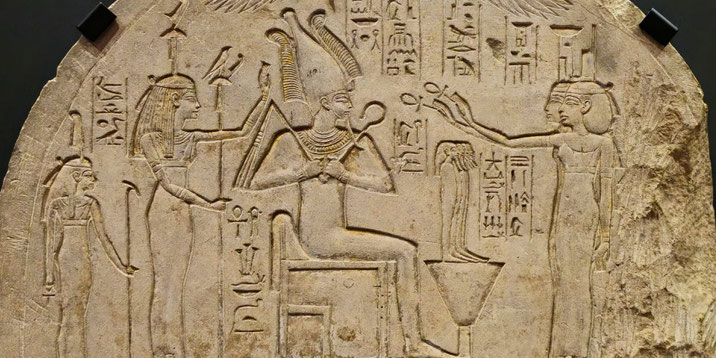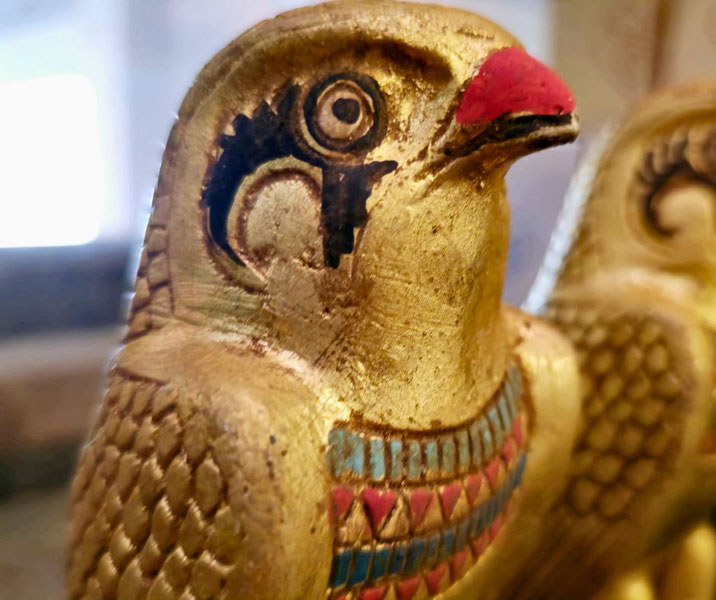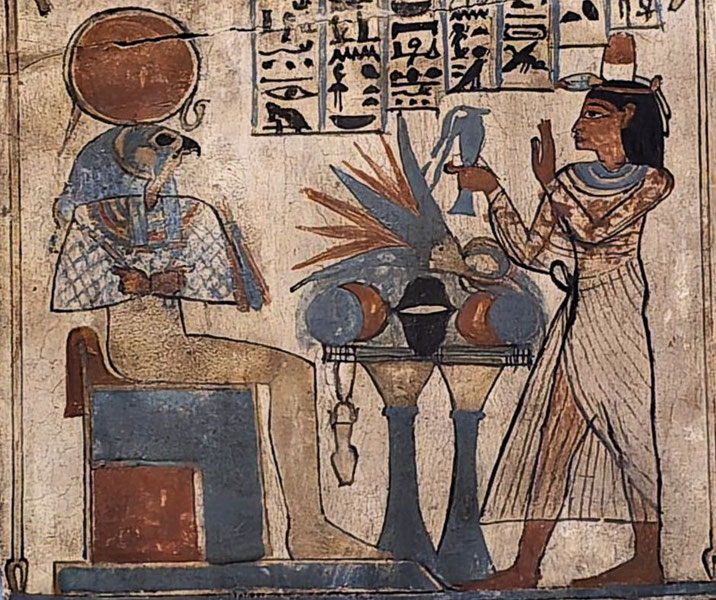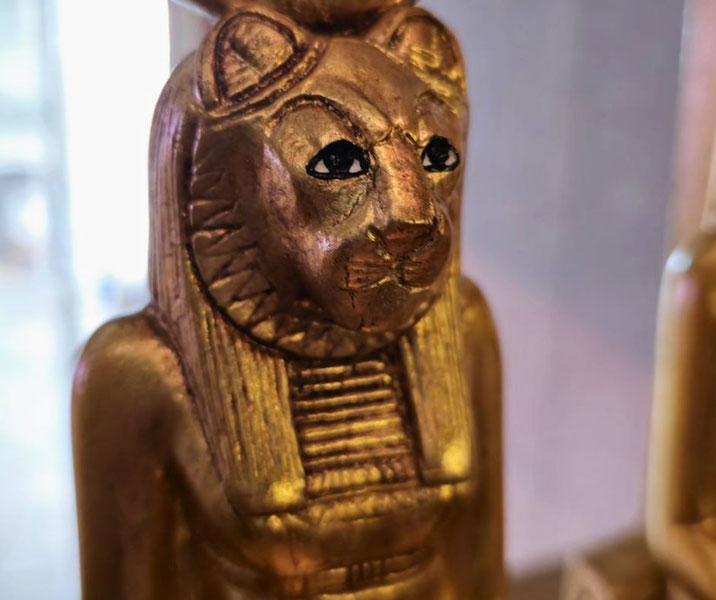How did Ancient Egyptian religion work?

One of the most fascinating elements about ancient Egyptian society is their religion. Over its 3000-year history, the belief systems of the Egyptians were constantly changing with various gods increasing and decreasing in importance at different times.
The Egyptians worshiped a pantheon of hundreds of deities, and they believed that each one was crucial controlling different elements of the natural and supernatural world.
In villages and cities across the kingdom, priests aimed to please these gods by conducting elaborate rituals and offering real food and drink to whichever god was of primary importance in their area.
Ultimately, the ancient Egyptians believed that by preforming these sacred rites in honour of the gods, that they could ensure the peace and prosperity of Egypt, both in this life and the next.
Who were the Egyptian gods?
One of the most important things to know about the ancient Egyptians is that they were polytheistic, which means they believed in more than one god.
In Egypt, these many gods would often take on human form and were thought to control various aspects of the physical world such as the sun, moon, rivers, agriculture, and so on.
However, there were also gods and goddesses who represented non-physical concepts such as love, wisdom, and war.
Since there were so many gods, not all of them were treated with the same respect or reverence in all parts of Egypt.
Some of them were only important in certain villages or in particular family households.
For example, there was Taweret, who was the goddess of childbirth and was a composite creature with the body of a pregnant hippopotamus, the limbs of a lion, and the back of a crocodile.
Then, there was Bes, the bearded dwarf god of fertility, and protector of households, particularly of mothers and children.
Also, there was Bastet, the cat goddess, who symbolized protection, fertility, and motherhood.
She was particularly worshipped in the city of Bubastis.
These kinds of gods were considered of minor importance and did not typically have their own temples or priests.
Instead, the common people built their own household shrines to honour these deities.
In contrast, there were other gods who were believed to be important enough in a particular local region to have their own have small temples built with priests to look after them.
Some of these include Hathor (the cow-headed goddess of fertility at Dendera), Horus (the falcon-headed god at Edfu), and Khnum (the ram-headed god at Elephantine).
Then, there were a few select divinities were so important that their worship was endorsed by the royal government.
As a result, they built vast temples to worship them throughout Egypt, and paid for priests to staff their complexes full-time.
Some of these gods may have only been of regional importance in the past, but over time, were elevated in prominence by a particular pharaoh or family.
These kinds of gods have become the most famous because there are many remains of their temples across Egypt.
Examples of these most powerful gods include the gods Atum (the creator sun-god who originated from Heliopolis), Ptah (the creator god who originated from Memphis), and Amun (the supreme god who originated from Thebes).
The Duat: Egypt's terrifying underworld
Most Egyptians believed that the various gods lived simultaneously in two different places: the physical world of mortals, as well as the spiritual world of the gods.
The name of the spirit realm was known as the Duat and was a mysterious place where gods and monsters interacted.
It is also the place where the souls of the deceased had to journey through after death in order to reach the afterlife.
Understanding the Duat is difficult for modern readers because the Egyptians never described it in great detail.
Instead, we see brief references to it in different places and times. As much as we can work out, the people seemed to believe that it almost mirrored the geography to Egypt itself.
It was through to have rivers, islands, and mystical landscapes. As a result, souls travelled through this place were at risk of harm, and even death, from the creature who existed in it.
However, there were some of the gods who lived there that could helped out. These included the gods of the underworld, Anubis and Osiris.
How did Egyptians believe the world was created?
Unlike the major religions of today, the Egyptians did not have a single story to explain the creation of the world.
Instead, they claimed at various times in history that different gods were considered the main 'creator god'.
In fact, each of the important religious sites across Egypt developed its own version of the myth in which their particular god played the leading role.
Regardless of who the key god was, the competing versions of the creation story tended to follow a standard story.
It started with the world as a place of chaos, where there was only darkness and water.
Then, the main god would create dry land out of this watery chaos. In the most famous version of this story, the god Atum rose up out of the water and created the first piece land in the shape of a small period.
This was called the ben-ben, or 'sacred mound'.
Next, he also created the next two gods: Shu (the god of air) and Tefnut (the goddess of moisture).
Shu and Tefnut then gave birth to Geb (the god of earth) and Nut (the goddess of sky).
It was these four gods that represented the basic elements of creation: earth, air, fire, and water.
Finally, the myth claims that Atum then created the first humans out of his own body. He blew life into them, and they began to live.
The Ennead
As you can see, some gods were more important and powerful than others in Egyptian religion.
It appears that the people believed there was a heirarchy among the gods as there was among humans on earth.
Therefore, some gods were similar to the royal family of the pharaoh, in that they were a powerful family that worked together.
The most important group of gods in ancient Egyptian religion was known as the Ennead.
This group consisted of nine gods who were thought to be responsible for the creation and maintenance of the universe.
It included Atum, Shu, Tefnut, Geb, Nut, Osiris, Isis, Set, and Nephthys. As a result, these gods were often depicted in art together: some as human beings and others with the heads of animals on top of human bodies.
Osiris, god of the dead
One of the most important stories in ancient Egyptian religion was the story of Osiris.
Osiris was a god who represented a range of different concepts, including fertility, agriculture, and even resurrection from the dead.
He was also considered to be the divine king of Egypt. He was married to his sister, the goddess Isis.
However, Seth (Osiris' brother) was jealous of Osiris' kingship and wanted to rule Egypt himself.
As a result, Seth killed Osiris, and cut his body into pieces before scattering them across the world.
Osiris' sister/wife, Isis, was heartbroken and sought help from her sister, Nephthys (who was Seth’s wife) to give his body a respectful burial.
The two goddesses travelled throughout the land and collected all of the pieces back together again.
The god Ra also ordered Anubis, god of embalming, and Thoth, god of wisdom and magic, to help them with the burial.
So, Anubis wrapped Osiris' body in bandages (to represent mummification), and Thoth taught Isis specific magic words to recite over her husband's remains.
Once the words were spoken, Osiris magically came back to life: resurrected from the dead.
However, Osiris could only live in the underworld since he was both alive and dead at the same time.
This story as described above is known as the Osirian cycle, and it was thought to represent the cycle of death and rebirth which could be observed in nature.
Based upon this myth, the Egyptians believed that if they could pass through the Duat and reach Osiris, then they too would be resurrected in the afterlife.
Therefore, this led to the development of a range of different funerary practices in Egypt, such as mummification.
This was designed to preserve the body so that it could be judged by Osiris.

Horus
However, the myth of Osiris and Isis doesn't end there. The husband and wife had a son together, who was another god called Horus.
Horus decided that he needed to take revenge on his uncle Seth for the murder of his father.
There are many different versions of the myth about how Horus defeated Seth, which include a wide range of physical challenges and power struggles.
However, they all conclude with Horus being declared the true heir to the throne of Egypt rather than Seth.
As a result of this myth, Horus became the god of kingship in Egypt, and pharaohs used Horus' imagery when depicting themselves in artwork.
In some mysterious way, it appears that the Egyptians believed that each pharaoh was the actual embodiment of Horus himself on earth, which made the pharaohs gods themselves.

The sun god Ra
Another important god in ancient Egyptian religion was Ra, the sun god. He was thought to be the creator of all life and was often depicted as a man with the head of a hawk.
Ra was believed to travel through the sky in the solar barque during the day and through the underworld in the Duat at night, battling the serpent Apophis.
As a result, the Egyptians believed that Ra gave them life and protected them from evil.
In the Old Kingdom period, they also believed that Ra had the power to bring the pharaoh back to life in the afterlife following their death.
This made him one of the most important gods in the first 1000 years of ancient Egypt.
Later in Egyptian history, during the New Kingdom period, Ra was merged with the god Amun, to become Amun-Ra.
This composite god was then considered to be the most important of all Egyptian gods.

Sekhmet
However, one other goddess that was particularly revered by the Egyptians was called Sekhmet.
She was depicted as a woman with the head of a lioness. She both represented the protective nature of mothers, but also had the capacity to inspire bloodlust among soldiers on the battlefield.
One particularly famous myth told how Sekhmet wanted destroyed the entire world when she became angry with humanity in order to drink their blood.
She was only stopped from carrying out her murderous slaughter when the god Ra tricked her by pouring beer into a lake and telling her it was blood.
Sekhmet then drank so much of the beer that she fell unconscious, and the world was saved.

Why did the Egyptians believe in magic?
Magic was also an important part of ancient Egyptian religion. The Egyptians believed that it could be used to control other people and make them do what they wanted.
This belief led to the development of a whole range of magical practices, including quite complex spells and charms.
Specifically, Egyptians used the word 'Heka' for magic. It denoted a range of magical practices which were used for a variety of purposes, such as protection, healing the sick, making someone fall in love with you, warding off evil spirits, or simply bringing good luck.
The role of priests
As is to be expected, priests played a very important role in ancient Egyptian religion.
In particular, they were responsible for performing rituals and they also acted as mediators between the people and the gods.
Almost always, priests were men, but there were some rare female priestesses who were dedicated to goddesses.
Primarily, the role of the priest was to act as the servant to the god, just as slaves served their masters in real life.
Every day, priests had to conduct specific rituals which involved offering food and drink to the god's statue to 'eat and drink'. Also, the priests bathed and dressed the statues.
These actions may seem strange to us, but the Egyptians really believed that the gods existed in these stone representations of the gods and that if these rituals were not carried out, the gods would become angry, and disaster would fall upon the kingdom.
Some of these rituals were considered to be so important that they were usually conducted by the high priest who acted on behalf of the pharaoh himself.
In addition, only the pharaoh and the high priest were permitted to enter the innermost sanctuary of the temple, which is where the god’s statue was located.
Famously, priests were required to shave their entire bodies, as it was thought that this would make them purer and more able to communicate with the gods.
There was also a special class of priests were also involved in the rituals and ceremonies associated with the mummification process.
Mummification was a long and complicated process that usually took priests around 70 days to complete.
The role of the pharaohs
The pharaohs, who were the rulers of ancient Egypt, were thought to be direct descendants of the gods, and so they had a very important role to play in religion.
They were responsible for maintaining balance in the world and keeping order.
They did this by carrying out religious ceremonies and building temples to the gods.
As a result, one of the most important deities for pharaohs was the goddess called Ma'at. Ma'at was the goddess of truth, justice, and order.
Pharaohs were expected to uphold Ma'at's values and to represent her in their actions.
The role of temples
Finally, temples were a central part of ancient Egyptian religion. They were places where people could go to worship the gods and offer them gifts.
Temples were also used for storage, as they contained many valuable items that belonged to the gods.
A number of Egyptians temples even held libraries where important knowledge was stored, either written on papyri or on inscribed tablets.
The largest temple in ancient Egypt was the temple of Amun at Karnak. It was over 500m long and contained over 100 chambers.
During the New Kingdom, it was one of the most sacred places in all of Egypt.
However, the most important belief was that a temple structure was considered to be the home of a god.
This meant that temples were very carefully designed and built to reflect this belief.
So, just like people's own houses, temples had doorways (called pylons), meeting areas (called hypostyle halls), storerooms for the god’s possessions, kitchens (including breweries, bakeries and butcheries), washing areas (such as sacred lakes), and living rooms (called the inner sanctuary).
Further reading
What do you need help with?
Download ready-to-use digital learning resources
Copyright © History Skills 2014-2025.
Contact via email
With the exception of links to external sites, some historical sources and extracts from specific publications, all content on this website is copyrighted by History Skills. This content may not be copied, republished or redistributed without written permission from the website creator. Please use the Contact page to obtain relevant permission.





